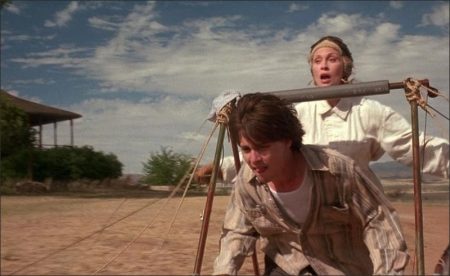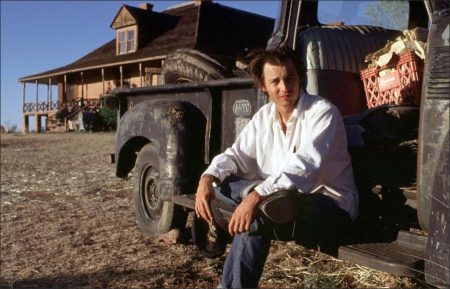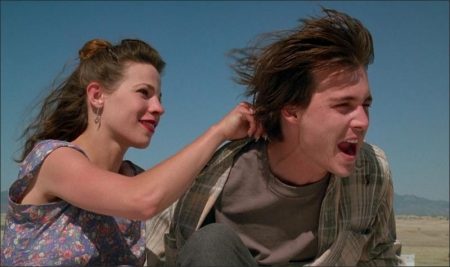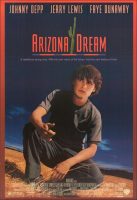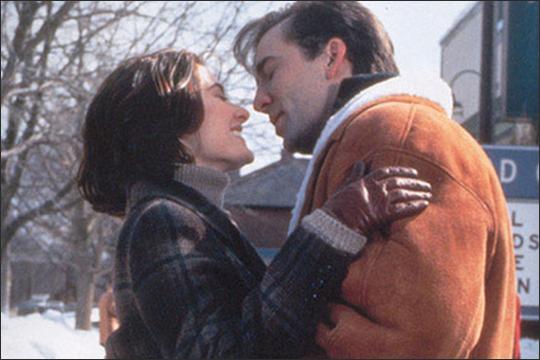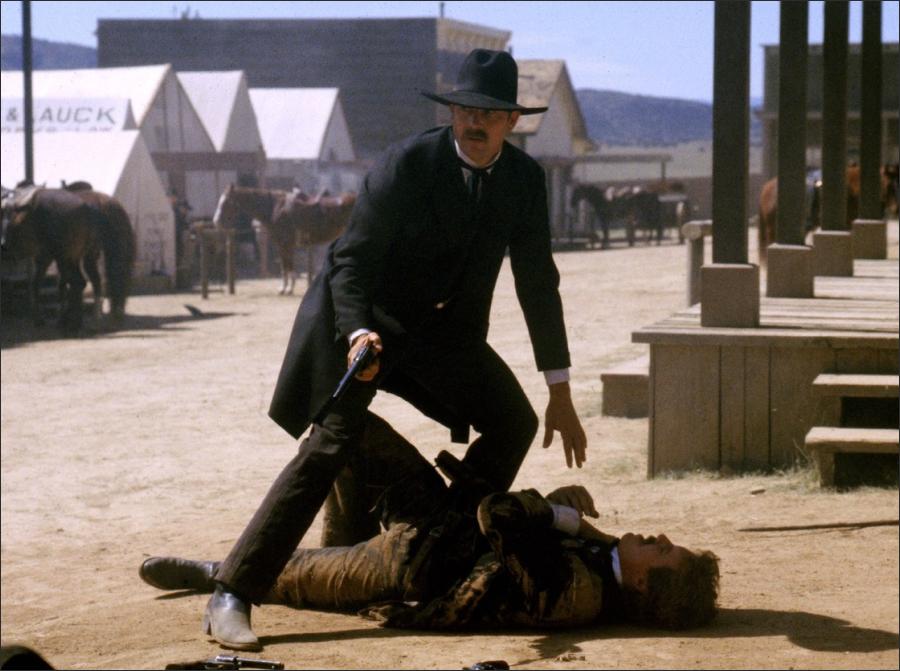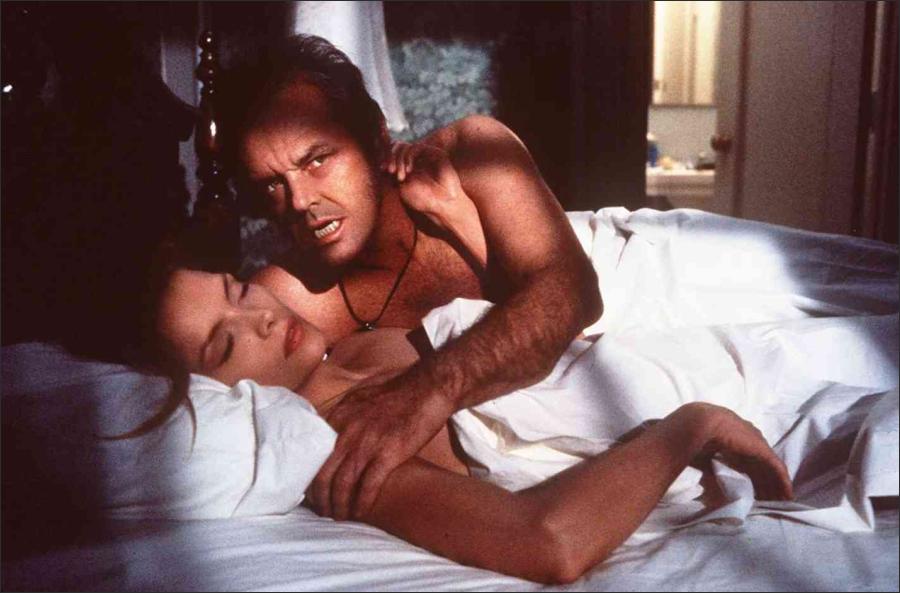Taglines: A rebellious young man. With his own vision of the future. And his own fantasy of love.
Arizona Dream movie storyline. An Innuit hunter races his sled home with a fresh-caught halibut. This fish pervades the entire film, in real and imaginary form. Meanwhile, Axel tags fish in New York as a naturalist’s gofer. He’s happy there, but a messenger arrives to bring him to Arizona for his uncle’s wedding. It’s a ruse to get Axel into the family business. In Arizona, Axel meets two odd women: vivacious, needy, and plagued by neuroses and familial discord. He gets romantically involved with one, while the other, rich but depressed, plays accordion tunes to a gaggle of pet turtles.
Arizona Dream is a 1993 American surrealist comedy drama film co-written and directed by Emir Kusturica and starring Johnny Depp, Jerry Lewis, Faye Dunaway, Lili Taylor, Vincent Gallo, Paulina Porizkova, Michael J. Pollard, Candyce Mason, Alexia Rane and Polly Noonan.
Film Review for Arizona Dream
“Arizona Dream” is the quintessential Nuart movie. It’s a dazzling, daring slice of cockamamie tragicomic Americana envisioned with magic realism by a major, distinctive European filmmaker, the former Yugoslavia’s Emir Kusturica. He also directed the Oscar-nominated “When Father Was Away on Business” and “Underground,” which took the Palme d’Or at Cannes this year.
It has an iconic cast that only a film buff could come up with–Johnny Depp, Faye Dunaway, Jerry Lewis, Lili Taylor and Vincent Gallo, plus Paulina Porizkova and Michael J. Pollard. The Nuart, of course, is showing it in its lengthy yet rewarding 142-minute director’s cut. Written by David Atkins, a student of Kusturica at Columbia University, “Arizona Dream” is a kind of cross between Gus Van Sant and Robert Altman. As determinedly hip as it is, however, it most likely will cut as deep five years from now as it does today.
It opens with an extended Eskimo sequence–the meaning of which will eventually become clear–that turns out to be a dream of Depp’s Axel Blackmar. At 23, Axel has found contentment both living in Manhattan, “where you can see everybody and nobody can see you,” and counting fish for New York’s Department of Fish and Game. Then he’s summoned back to his hometown in Arizona, where his Uncle Leo (Lewis), the local Cadillac dealer, is marrying his “little Polish cupcake” (Porizkova) and wants Axel to be his best man.
In an instant, the likable, laid-back Axel is caught up in a caldron of other people’s guilt and dreams. There is a strong bond of love between Axel and Leo–Depp interacts with Lewis as warmly as he did with Marlon Brando in “Don Juan de Marco”–but Leo cannot forgive himself for having been the driver of a car in which Axel’s parents were killed in an accident six years earlier.
Leo fears that Axel will end up a bum, and he wants to make a Cadillac salesman out of him. Gallo plays Paul, one of Leo’s employees, who’s supposed to show Axel the ropes. Paul has a dream, too, of becoming an actor; he can recite the dialogue of “Raging Bull” and comes up with the most confounding impression of Cary Grant running from the crop-duster in “North by Northwest.”
Just as he’s bending to his loving uncle’s will, Axel becomes swiftly entangled with Dunaway’s manic-depressive Elaine Stalker and her oppressed stepdaughter, Grace (Taylor). It seems Elaine fatally shot her husband–the circumstances aren’t too clear–but she and Grace at times blame each other.
In any event, Grace has ended up inheriting the state’s third-largest copper mine, and the two women–bonded more by love and loneliness than hatred–live in a vast Victorian ranch house outside town. Initially, Axel is more beguiled by the glamorous, sexy Elaine and her dream of building a flying machine a la the Wright Brothers than by Grace, who talks about suicide and hopes for reincarnation as a turtle.
Working from what must be a most ambitious screenplay, Kusturica lays on the eccentricities and extravagant behavior of his people thick, pushing them to caricature, then providing them with surprising dimension. In Elaine, Dunaway in particular has found one of her most challenging roles as an extremely mercurial, outrageous woman with an image of a crazed nymphomaniac whose vulnerability and longing actually expresses an acute perception.
Of course, Lewis is funny, but he also gives a serious, endearing performance of one of the most normal men he has ever played. Taylor is at her best as a young woman in need of discovering her own identity. Depp yet again reveals his unique ability to be the seductive yet compassionate idealist, discovering strength in tenderness. Although not quite in the center of action, Gallo nonetheless is a sure-fire scene-stealer. Porizkova and Pollard (as a nerdy would-be customer Leo gives the brushoff) score in brief appearances.
Amid a maelstrom of emotion and calamitous action, Kusturica manages to suggest not merely Axel’s need to pursue his own dream–that’s clear enough–but to evoke a sense of the ultimate isolation of us all and to jolt us with juxtapositions of comedy and tragedy, and of life and death themselves.
Arizona Dream (1994)
Directed by: Emir Kusturica
Starring: Johnny Depp, Jerry Lewis, Faye Dunaway, Lili Taylor, Vincent Gallo, Paulina Porizkova, Michael J. Pollard, Candyce Mason, Alexia Rane, Polly Noonan
Screenplay by: David Atkins
Production Design by: Miljen Kreka Kljakovic
Cinematography by: Vilko Filac
Film Editing by: Rached M’Dini, Andrija Zafranovic
Costume Design by: Jill M. Ohanneson
Set Decoration by: Jan Pascale
Art Direction by: Jan Pascale
Music by: Goran Bregovic
MPAA Rating: R for language and sexuality.
Distributed by: Warner Bros. Pictures
Release Date: January 6, 1993 (France), September 9, 1994 (US)
Hits: 202
